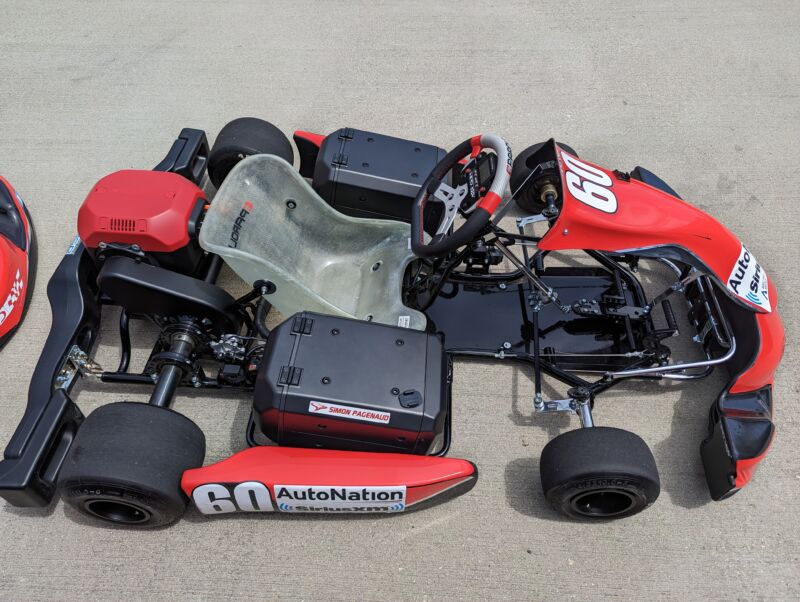LONG BEACH, Calif.—Honda has its hands in all kinds of businesses, from lawnmowers and power generators to IndyCar, go-karts, and consumer vehicles. Honda Performance Division (HPD) works explicitly on the high-performance and racing product line and builds, hones, and maintains everything from the hybrid powertrain we’ve seen in Acura’s LDMh race car to high-performance kart and motorcycle engines.
With a commitment to going carbon neutral by 2050, Honda has focused its attention on moving everything in its product line toward hybrid and electric powertrains, including a brand-new all-electric go-kart called the eGX Racing Kart Concept. The concept leverages Honda’s Mobile Power Pack, or MPP, and offers swappable batteries with plenty of power. We got a chance to drive the new eGX Racing Kart Concept on a small, multi-elevation track that Honda set up at the Acura Long Beach Grand Prix this month; zipping around in the tiny, powerful, and quick vehicles gave us a taste of the latest electric power plant from Honda.
Swappable, sharable batteries and an electric motor
The eGX Racing Kart Concept looks just like an e-kart you might see at a K1 Speed or other indoor karting track (minus the surround bumpers). It’s compact, simple, and minimal, and it can reach speeds of up to 45 miles per hour, according to Honda. It’s not Honda’s first electric kart, however, as the company built a kid’s e-kart called the Minimoto Go-Kart, which ran on a rechargeable 36-volt battery and reached speeds of 18 miles per hour. Honda no longer makes or sells the Minimoto, but you can still find them on eBay and Craigslist.
The eGX Kart features two technologies that Honda has had in the pipeline for years: the MPP and the company’s first lithium-ion battery-powered motor, the eGX. The MPP system is in limited use in places like Indonesia, the Philippines, India, and Japan, where customers driving Honda’s electric motorcycles or three-wheeled delivery vehicles with the MPP system can stop at a service center, much like a gas station, drop off their spent MPP packs, and drop in new ones to continue on their way. Consumers lease the batteries they use and simply swap them out. Honda says the MPP system has been in use since 2018, when it introduced the Gyro Canopy three-wheeled delivery vehicle, and the company has continued to test and refine the system in select markets.
The battery swap is surprisingly easy and can be done in under a minute. Pop open the battery housing, slide out the easy-to-grab battery pack, and slide a new one in. Put the spent battery into the charger, and you’re ready to go. The battery design is elegant and simple—you can’t put it in the wrong way because of the way Honda has designed the packaging, and if the battery is seated wrong, the housing won’t close, preventing accidental misalignment and potential problems.
Each MPP supplies around 1.31 kWh of power, and Honda says that allows for a run time of around 35 to 45 minutes before the batteries need to be recharged. The batteries recharge in chargers that can be mounted on a wall or set into a small compact floor charger, where they take around five hours to fully recharge, according to Honda. The company has been investigating how to use the MPP system as a way to store renewable energy for everything from vehicles to corporations.
The eGX motor is a high-power, three-phase brushless DC power unit that incorporates insulation and coiling technology from Honda generators. The 2-kW-class motor can run between 3,000 and 3,600 rpm and gets internal and external cooling fans to dissipate heat. There are also rubber mounts on the motor, power drive unit, and battery pack to reduce vibration and extend the life of the motor. The motor in the eGX kart has been tuned by HPD to provide more performance and power.
Honda says the kart weighs around 230 lbs (104 kg) without the two batteries that sit just behind the driver at each hip. Each battery pack weighs around 26 lbs (12 kg), bringing the total weight of the kart to just shy of 300 lbs (136 kg). That’s still heavier than most gasoline-powered kid karts (which weigh anywhere from 150 to 175 lbs/68-79 kg, roughly), but it’s on par with many karts that adults race in various karting series.
On the short track that Honda set up for us, the karts were quick, powerful, and silent. Because karts don’t have power steering, they require quite a bit of strength to maneuver, especially with their weight. During the event, four IndyCar drivers competed against each other and were closely matched on the very short track.
So why has it taken this long for Honda, one of the few major OEMs in the karting space, to build another all-electric kart? Honda says it’s a result of battery technology, safety, and weight. As battery technology gets better and more power is available from smaller, lighter, and safer battery packs, electric karts will become more feasible and affordable. Honda says most e-karts cost anywhere from $12,000 to $14,000, but since the eGX Racing Kart is still a concept, company reps didn’t have details on what the e-kart might cost—or if it will actually land in consumers’ hands.
Beyond just go-karts
While creating an all-electric go-kart seems like relatively small potatoes for a massive corporation like Honda, the eGX Racing Kart Concept is less about creating a fun, fast, green go-kart and more about showing off future technology that Honda and HPD are creating—specifically the quiet, powerful eGX motors and the MPP battery technology that has been demonstrated in everything from Honda ATVs and side-by-sides to generators and robotics concepts. Honda is pushing for a future where everything from our lawnmowers to go-karts would work with the MPP system and its swappable, sharable battery platform.

